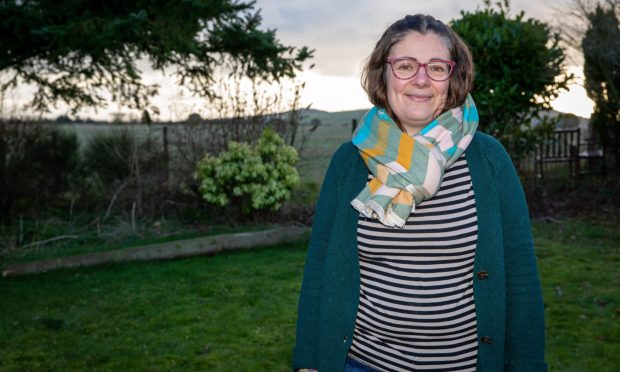Morrison’s Academy has become a lot noisier in the last few weeks – but with the “right noise”, says rector Andrew McGarva.
The reason? There’s not a mobile phone in sight.
The Crieff school has, with a few exceptions, banned pupils from using phones from the moment they enter the gates in the morning until they leave.
And that’s created a sense of freedom, greater confidence, better relationships and more physical activity, says Mr McGarva.
During a lunchtime wander around the grounds of the independent school we see a group of boys playing football.
Nearby stands a large crowd of girls laughing and chatting.
Heads are up. Unlike in most secondary school playgrounds and corridors, no one is looking down, scrolling.
“It’s a nicer environment at lunchtime,” says S5 pupil Lollie.
“Before, people would just sit down and go on their phones.”
What are the rules?
The rules are: S1 to S5 pupils must switch off and put away phones, smartwatches and headphones at the school gates.
Any phones seen by staff are confiscated for collection at the end of the day.
S6 pupils can use devices responsibly in designated areas.
Excluded from the rules are those with medical conditions or special needs which necessitate a mobile phone.
This approach came into force in August, prompted by mounting evidence of the detrimental impact of smartphone overuse on mental health, education and wellbeing.
Mr McGarva says: “In the last year I’d noticed there were more children coming out of classrooms and going straight on to phones and checking for messages. And to be honest, I found myself doing that as well.
“On duty at break times I’d see pupils sitting on a bench, chatting away, but they’d be on their phones. They weren’t really engaging well with each other.”
Why did Morrison’s Academy call time on smartphones?
Mr McGarva was worried about how that was affecting their mental health and social development.
“All schools are dealing with children with mental health problems,” he says. “It’s a much bigger issue than I remember at any point in my 25-year career.
“Some of the research says if you’re sitting on a phone scrolling away, looking at all these things is having an effect on you and it is having an impact on your relationships.”
His staff had similar concerns.
Geography teacher Shona Collister says: “As they walked out the classroom the first thing they did was pull their phone out. Even if it was just to check their timetable they were then distracted by social media, messages, whatever.
“You’d see them walking along the corridor looking at phones.
“It was almost like a social crutch. If you were slightly introverted you could look at your phone and you didn’t have to interact with people.”
Schools, mobile phones and ‘The Anxious Generation’
Reading Jonathan Haidt’s book The Anxious Generation, which talks about the impact of screens and the ‘great rewiring of childhood’, further convinced Mr McGarva to act.
The proposed new policy and the reasons for it were presented to pupils, staff and parents.
While almost all parents were on board, there was some resistance from pupils, says Mr McGarva.
“Some were ‘no, no, no’ but some thought it was actually a really good idea. They realised they were using their phones too much.”
Indeed that’s a benefit now seen by Libby in S5.
“It’s quite nice to come to school and have a break from your phone,” she says.
“I talk to people now I didn’t talk to before and we have lot more interesting conversations.”
‘It’s not a full ban – they need a safe place to make mistakes’
Mr McGarva stresses there’s not a full ban on mobile phones. There are occasions when it’s appropriate to permit pupils to use them.
“I don’t like the idea of a full ban,” he says. “I didn’t come into education to ban things, I came into education to educate children and give them strategies for coping.”
Children, he says, need to learn appropriate use of phones so they can take that into the workplace.
“We need to give them boundaries and a safe place to make mistakes.”
And only a few confiscations have been made, he says.
But the benefits appear to be many.
Malindi, in S4, says: “It’s definitely more sociable at lunchtimes.
‘In awkward moments we would go on phones’
“Before, if there was an awkward moment we would just sit on our phones. Now we can all talk to anybody.
“There are lot more conversations happening.”
Pupils are more physically active.
S5 pupil Cameron says: “People are branching out more towards co-curricular activities, like rugby after school, rather than just sitting on their phones.”
Numbers attending a basketball club he set up last year have soared, according to head of business and enterprise Craig Roy, and the school gym is in greater demand.
Has Morrison’s Academy new mobile phone policy worked?
“I think so,” says Mr McGarva. “Actually, I know so.”
Easier in an independent school
He acknowledges is probably easier for independent schools to ban or curtail mobile use among pupils.
However, he hopes other local authority schools considering doing so will be encouraged by the results at Morrison’s Academy.
New guidance issued by the Scottish Government on mobile phones in schools in August permits head teachers to introduce full bans if they feel it necessary.
Mr McGarva likes what he sees during his lunchtime duties and around the school.
“One thing I love is, there’s a big group of S3 girls, about 14 of them, who sit on the lawn and just chat.
“Previously there would be smaller groups and always a couple would be on their phones and one looking around.
“In the corridor, I’m not having to tell pupils to look up.
“They’re actually talking with each other. Before, there would two or three walking along checking their messages or whatever. A few of the boys would be gaming.
“There are more conversations going on.
“It’s a bit noisier here,” says Mr McGarva, “but it’s the right noise.”
Check out our debate piece asking ‘should mobile phones be banned in schools?’.

















Conversation